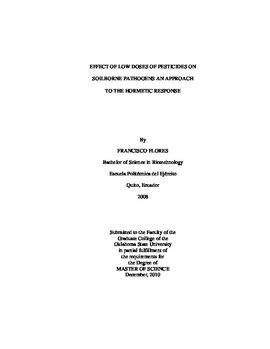| dc.contributor.advisor | Garzon, Carla | |
| dc.contributor.author | Flores, Francisco | |
| dc.date.accessioned | 2014-04-15T21:16:45Z | |
| dc.date.available | 2014-04-15T21:16:45Z | |
| dc.date.issued | 2010-12-01 | |
| dc.identifier.uri | https://hdl.handle.net/11244/8994 | |
| dc.description.abstract | The effects of doses below the no observed adverse effect level (NOAEL) of disinfectants and commercial fungicides on the growth of Rhizoctonia zeae, Rhizoctonia solani, and Pythium aphanidermatum in vitro were assessed. A benchmark dose value (BMD), was determined for each chemical. Each organism was grown on solid growing media amended with two disinfectants and fungicides at different doses, with a minimum of five doses below the BMD, and a non amended control. The modeling of the hormetic effect and the inference of EC50 and NOAEL were done using a Brain-Cousens model. An increase of growth at low doses of ethanol was observed for both R. zeae and P. aphanidermatum, while sodium hypochlorite showed no stimulation. Non-monotonic responses were also observed on the dose effect of cyazofamid and of propamocarb on P. aphanidermatum. In contrast, propiconazole didn't show a hormetic effect on either R. zeae or R. solani. Due to the different modes of action of the chemical agents that rendered hormetic responses on the radial growth the organisms in vitro, multiple factors are suspected to be responsible for this phenomenon. An accurate experimental design and a sensitive data analysis tool were necessary to detect the hormetic response consistently. Results suggest that hormesis may not be a generalizable phenomenon in biology but it could have a relationship with the plasticity of an organism. This study provides, for the first time, evidence that the phenomenon of hormesis occurs in oomycete and fungal plant pathogens in response to doses of disinfectants or pesticides. | |
| dc.format | application/pdf | |
| dc.language | en_US | |
| dc.publisher | Oklahoma State University | |
| dc.rights | Copyright is held by the author who has granted the Oklahoma State University Library the non-exclusive right to share this material in its institutional repository. Contact Digital Library Services at lib-dls@okstate.edu or 405-744-9161 for the permission policy on the use, reproduction or distribution of this material. | |
| dc.title | Effect of Low Doses of Pesticides on Soilborne Pathogens an Approach to the Hormetic Response | |
| dc.type | text | |
| dc.contributor.committeeMember | Walker, Nathan | |
| dc.contributor.committeeMember | Smith, Damon | |
| osu.filename | Flores_okstate_0664M_11155.pdf | |
| osu.college | Agricultural Sciences and Natural Resources | |
| osu.accesstype | Open Access | |
| dc.description.department | Department of Entomology and Plant Pathology | |
| dc.type.genre | Thesis | |
| dc.subject.keywords | biphasic | |
| dc.subject.keywords | curve modeling | |
| dc.subject.keywords | dose response | |
| dc.subject.keywords | hormesis | |
